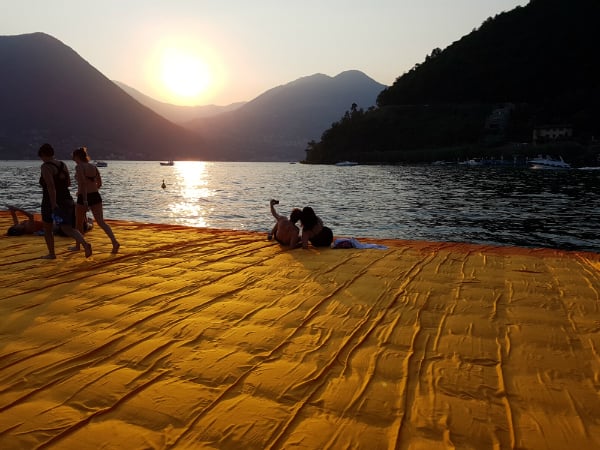
Last Thursday, June 23, I boarded a plane early in the morning at Berlin’s Schönefeld airport. One flight and a couple train transfers later, I was stepping onto Christo’s Floating Piers installation on Italy’s Lake Iseo, the sun glinting off the lake’s rippling surface and setting aglow the saffron-colored fabric draped over the three-kilometer-long water walkway.
Being from enormous, geographically isolated Canada, I never fail to marvel at how easy it is to hop from one nation to another in Europe. Not a single border checkpoint slowed my journey that day. Arriving in Italy, I paid for my train tickets with the same Euro notes that I use back home in Berlin.
While I was making my way to the little town of Sulzano in the northeast region of Lombardy, more than 33 million UK citizens were casting their votes in the Brexit referendum. By the time the polling stations closed that night, it was done: A small majority of 52 percent had tipped the balance in favor of their country leaving the European Union after more than four decades in, setting into motion a political, economic, and social fallout that Britain, not to mention the rest of Europe, is still reeling from today.
Christo’s Floating Piers. Photo courtesy of Hilda Hoy
I doubt Brexit was on the minds of any of the thousands of people experiencing Christo’s magnanimous installation that Thursday. We were all too busy frolicking across the water, marveling at the scenery, and snapping selfies. And I’m sure any such symbolism was the furthest thing from the artist’s intentions—he and his late wife Jeanne-Claude first hatched the idea for the piers in the 1970s. “All the artwork Jeanne-Claude and I do is work of joy and beauty. They don’t serve anything except to be a work of art,” he said in an interview with Italian newspaper Corriere della Sera in April.
I could see that joy on people’s faces, and I felt it myself. The atmosphere was one of glee and exhilaration, despite the sweltering glare of the sun. As I walked across the lake, I took off my shoes, as did many others, to feel a connection to the springy, buoyant surface beneath my feet and the gentle rhythm of the water undulating in the wake of passing boats. Around me I heard mostly Italian, but also French, English, German, Swedish, Spanish, Chinese. Parents pushed their toddlers in strollers, others pushed their loved ones in wheelchairs, kids spun cartwheels, and dogs pranced, not even the animals immune to the mood of excitement. There was something quite democratic about the whole thing, which the artist always insisted must be free and open. “The Floating Piers are an extension of the street and belong to everyone,” Christo has said of the project, the entire cost of which—€15 million—came out of his own deep pockets.
Christo’s Floating Piers. Photo courtesy of Hilda Hoy
The idealism of The Floating Piers is earnest, and it is enticing. It would be naïve, however, to ignore the reality. Truth is, the region is buckling under the influx of the tens of thousands who show up every day eager to experience the piers for themselves. Christo’s vivid fabric has become stained and ripped under the shuffling footsteps of well over half a million visitors, the rows of portable toilets on the shoreline reek in the sun, and I can’t imagine the local residents aren’t fervently awaiting the coming day when they can have their peace and quiet back.
Many trains into Sulzano have been cancelled due to dangerous overcrowding, roads closed, thousands of irate and desperate travelers stranded. People have suffered heatstroke while they wait for hours, penned in like cattle, for the chance to step onto the piers, and extra security needed to be hauled in to keep the situation under control. Christo wanted the piers to be accessible 24 hours a day, but about a week in, the local mayor put his foot down, and now they close overnight.
There are many issues with the lumbering bureaucracy and the infighting of the EU, and the pressures of the migrant crisis over the last year have put the union to a serious test. Christo’s Floating Piers are beautiful in both their idealism and their execution, but they are also illustrative of the reality of what arises when you build bridges and connect two shores that fate set up to be separate.
Christo’s Floating Piers. Photo courtesy of Hilda Hoy
For the 16 days that the installation lasts, two isolated islands in the middle of the lake are joined for the first time in history to the mainland: Monte Isola, with a small but established tourism infrastructure, and San Paolo, a lone, isolated rock with only a single villa on it, owned by the multi-millionaire Beretta family, manufacturing firearms in the region since the 1520s. But these connections are short-lived. After July 3, the piers’ 220,000 polyethylene cubes will be crushed, shredded, and recycled, the 100,000 square meters of yellow-orange nylon fabric too, and the islands will be alone again.
As for Brexit, what will happen to the long-established and hard-won connections between the British Isles and the European continent remains to be seen. A country has voted for separateness over unity. The ideal of European togetherness has been shaken—perhaps it was always too utopian to begin with. By a coincidence of timing, Christo’s Floating Piers became a symbol of how art can (quite literally) bring people together, but also how these connections are fraught. Soon, the piers will disappear and life on Lake Iseo will go back to normal. The EU will go back to normal, too, though we already know it won’t quite be the same.